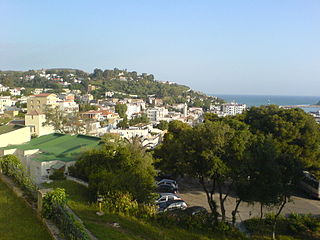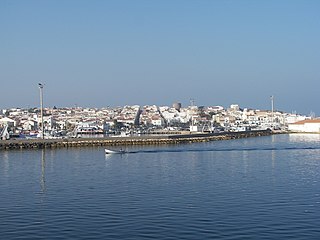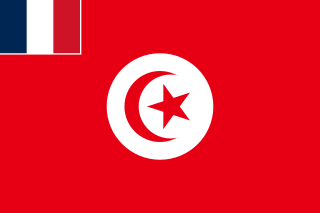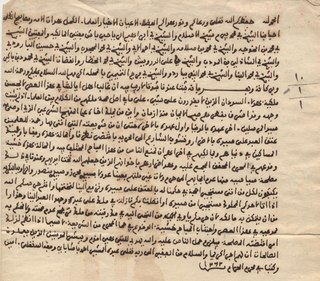
The Eighth Crusade was the second Crusade launched by Louis IX of France, this one against the Hafsid dynasty in Tunisia in 1270. It is also known as the Crusade of Louis IX Against Tunis or the Second Crusade of Louis. The Crusade did not see any significant fighting as Louis died of dysentery shortly after arriving on the shores of Tunisia. The Treaty of Tunis was negotiated between the Crusaders and the Hafsids. No changes in territory occurred, though there were commercial and some political rights granted to the Christians. The Crusaders withdrew back to Europe soon after.

The Republic of Genoa was a medieval and early modern maritime republic from the years 1099 to 1797 in Liguria on the northwestern Italian coast. During the Late Middle Ages, it was a major commercial power in both the Mediterranean and Black Sea. Between the 16th and 17th centuries, it was one of the major financial centres in Europe.

Tabarka is a coastal town located in north-western Tunisia, close to the border with Algeria. Tabarka was occupied at various times by Punics, Greeks, Romans, Arabs, Genoese and Ottomans. The town is dominated by an offshore rock on which there remains a Genoese castle. Nationalist leader Habib Bourguiba, later president of post-independence Tunisia, was exiled on Tabarka by the French colonial authorities in 1952. Tourist attractions include coral fishing, the Coralis Festival of underwater photography, and its annual jazz festival.

Tabarca, officially Nueva Tabarca and also known as Isla Plana (Spanish) and as Nova Tabarca and Illa Plana in Valencian, is an islet located in the Mediterranean Sea, close to the town of Santa Pola, in the province of Alicante, Valencian community, Spain. Tabarca is the largest island in the Valencian Community, and the smallest permanently inhabited islet in Spain. It is known for its marine reserve.

Hayreddin Barbarossa, also known as Hayreddin Pasha, Hızır Hayrettin Pasha, and simply Hızır Reis, was an Ottoman corsair and later admiral of the Ottoman Navy. Barbarossa's naval victories secured Ottoman dominance over the Mediterranean during the mid-16th century.

Calasetta is a small town and comune located on the island of Sant'Antioco, off the Southwestern coast of Sardinia, Italy.

The conquest of Tunis occurred in 1535 when the Habsburg Emperor Charles V and his allies wrestled the city away from the control of the Ottoman Empire.

Italian Tunisians are Tunisian-born citizens who are fully or partially of Italian descent, whose ancestors were Italians who emigrated to Tunisia during the Italian diaspora, or Italian-born people in Tunisia. Migration and colonization, particularly during the 19th century, led to significant numbers of Italians settling in Tunisia.
Abu l-Hasan Ali I, also known as Ali Bash or Ali Bey I,) was the second leader of the Husainid Dynasty and the ruler of Tunisia from 1735 to 1756.

Mustapha Khaznadar, born as Georgios Halkias Stravelakis was a Tunisian politician who served as Prime Minister of the Beylik of Tunis from 1855 to 1873. He was one of the most influential people in modern Tunisian history.

The French protectorate of Tunisia, officially the Regency of Tunis and commonly referred to as simply French Tunisia, was established in 1881, during the French colonial empire era, and lasted until Tunisian independence in 1956.

Dragut was an Ottoman corsair, naval commander, governor, and noble. Under his command, the Ottoman Empire's maritime power was extended across North Africa. Recognized for his military genius, and as being among "the most dangerous" of corsairs, Dragut has been referred to as "the greatest pirate warrior of all time", "undoubtedly the most able of all the Turkish leaders", and "the uncrowned king of the Mediterranean". He was nicknamed "the Drawn Sword of Islam". He was described by a French admiral as "a living chart of the Mediterranean, skillful enough on land to be compared to the finest generals of the time" and that "no one was more worthy than he to bear the name of king". Hayreddin Barbarossa, who was his mentor, stated that Dragut was ahead of him "both in fishing and bravery".

Ottoman Tunisia, also known as the Regency of Tunis, refers to the Ottoman presence in Ifriqiya from the 16th to 19th centuries, when Tunis was officially integrated into the Ottoman Empire as the Eyalet of Tunis. The Ottoman presence in the Maghreb began with the takeover of Algiers in 1516 by the Ottoman Turkish corsair and beylerbey Aruj, eventually expanding across the entire region except for Morocco. The first Ottoman conquest of Tunis occurred in 1534 under the command of Khayr al-Din Barbarossa, the younger brother of Aruj, who was the Kapudan Pasha of the Ottoman Fleet during the reign of Suleiman the Magnificent. However, it was not until the final Ottoman reconquest of Tunis from Spain in 1574 that the Turks permanently acquired the former territories of Hafsid Tunisia, retaining it until the French occupation of Tunisia in 1881.

Slavery in Tunisia was a specific manifestation of the Arab slave trade, which was abolished on 23 January 1846 by Ahmed I Bey. Tunisia was in a similar position to that of Algeria, with a geographic position which linked it with the main Trans-Saharan routes. It received caravans from Fezzan and Ghadamès, which consisted solely, in the eighteenth century, of gold powder and slaves, according to contemporary witnesses.

The Archipelago of Sulcis is located off the coast of Sardinia, and is part of the Province of South Sardinia. The archipelago is 160 square kilometres (62 sq mi) in land area.

Until 1815 the Beylik of Tunis maintained a corsair navy to attack European shipping, raid coastal towns on the northern shores of the Mediterranean and defend against incursions from Algiers or Tripoli. After 1815 Tunis tried, with limited success, to create a modern navy, which fought in the Greek War of Independence and the Crimean War.
The Dey of Tunis was the military commander of the janissaries in the regency of Tunis. In the seventeenth century the holders of the position exercised varying degrees of power, often near-absolute. Until 1591 the Dey was appointed by the Ottoman governor (“Pasha”). In 1673 the Dey and the janissaries revolted against Murad II Bey and were defeated. After this the hereditary position of Bey was pre-eminent in Tunis. The position of Dey continued to exist until it was abolished by Sadok Bey in 1860.
Giuseppe Raffo was a Tunisian businessman and politician who served on the Supreme Council of the Beylik of Tunis, fulfilling the main functions of a Minister of Foreign Affairs.
The Tunisian–Algerian War of 1807 was a conflict between the Beylik of Tunis and the Deylik of Algiers. The war led to the emancipation of Tunisia from any sort of Algerian influence, and the ending of the tribute paid by Tunisia to Algeria since 1756.

The Bombardment of Tripoli is a military operation of the Kingdom of France which took place between July 20 and July 27, 1728 against the current city of Tripoli, in Libya.
















